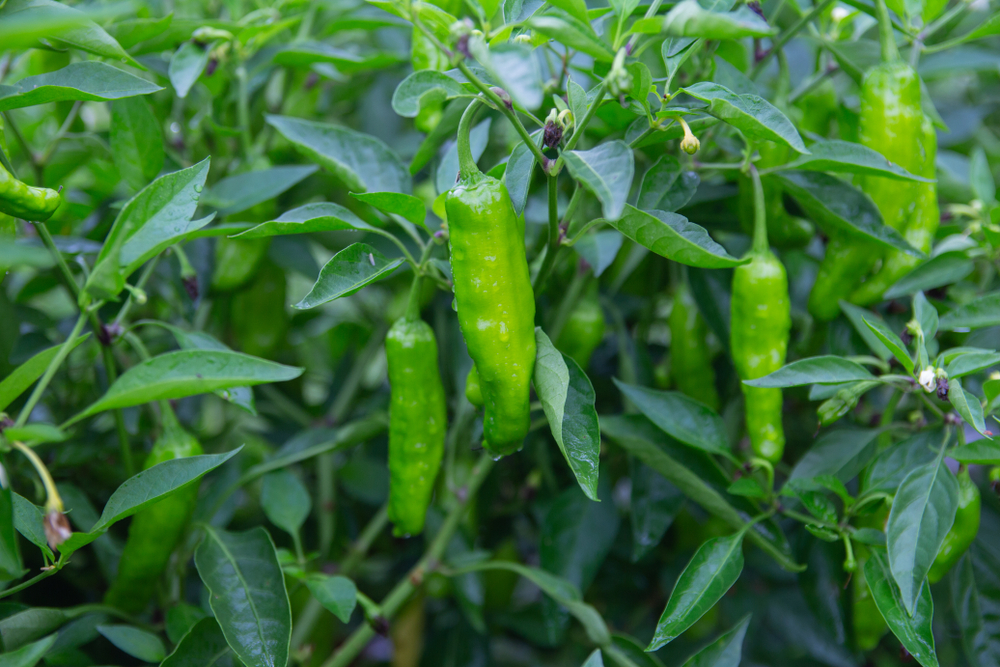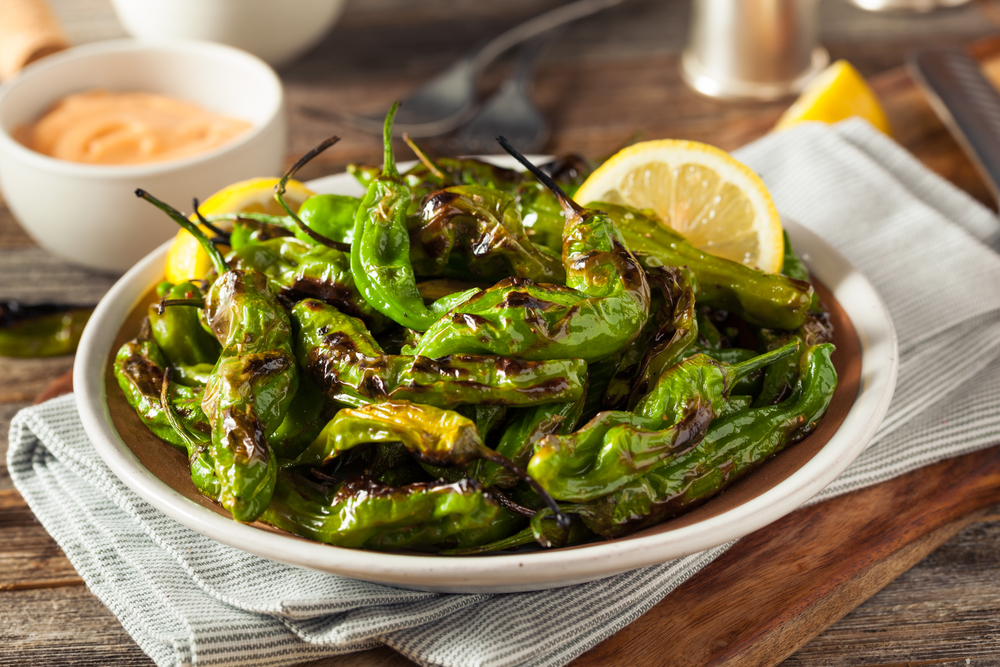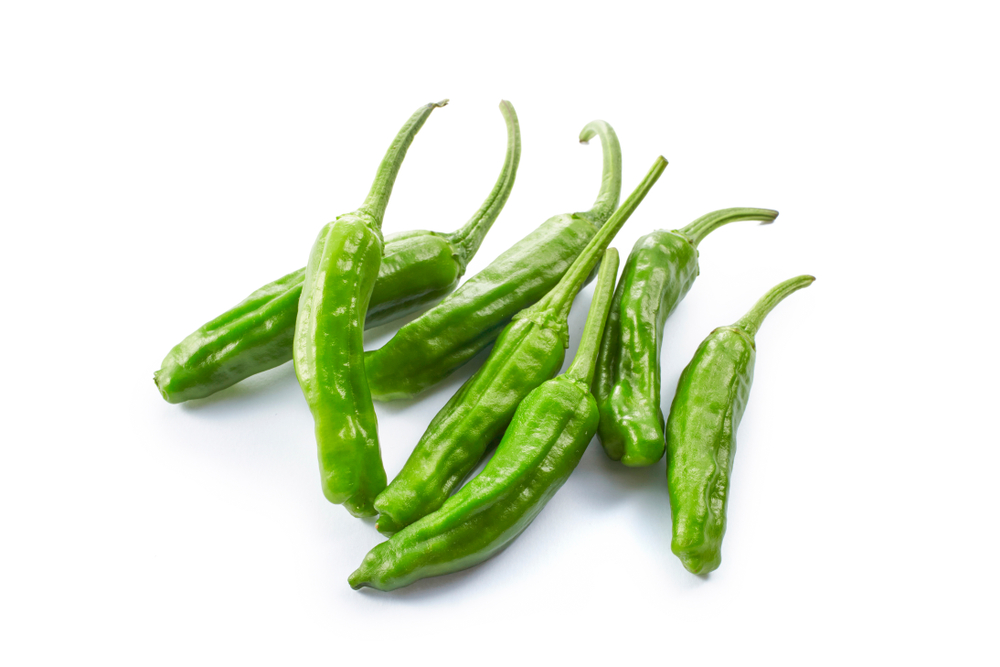Shishito peppers are small peppers native to Japan, famous for their unpredictable heat in different peppers. In their native country, they usually eat shishito peppers green as an accompaniment to beer or an appetizer when blistered.
What Is A Shishito Pepper?
A shishito pepper is an East Asian Capsicum annuum pepper usually eaten green but ripens to red at full maturity. The pepper is native to Japan but has become popular in the US and Europe as a snack or appetizer.
Shishito pepper is believed to have developed from padrón pepper or pimiento de padrón pepper, a famous Spanish pepper with similar characteristics.
The name ‘shishito’ borrows from ‘shishi’—the Japanese word for lion, and ‘togarashi’—the Japanese word for the Capsicum annuum species, which is generally translated to ‘chili pepper.’
The tip of shishito peppers folds into a crease similar to a lion’s head, hence the name.
In Korea, shishito peppers are called kkwarigochu or groundcherry pepper because they have folds and creases that resemble groundcherries.
Color
Shishito peppers start green and ripen to red when fully mature. Like most other peppers, you can harvest and eat the green pepper or wait a few more weeks for it to ripen on the vine for more heat and flavor.
Shape And Size
Like padrón peppers, shishito peppers are small, thin, finger-sized chili peppers about 3-5 inches long at full maturity. They have a fairly uniformly slender profile that tapers slightly toward the tip. The peppers can be straight or curved.
Texture
The skin of shishito peppers is thin and slightly wrinkled. Long folds and creases on the peppers’ bodies make them somewhat ugly.
Green shishito chili peppers are crispy. This firm texture is lost as the peppers ripen to red.
Flavor
The flavor of shishito peppers is sweet and slightly smoky.

What Is Special About Shishito Peppers?
Shishito peppers are famous for four things:
- they are a heat gamble
- they are easy to grow
- they are early-maturing
- they are highly prolific
Most pepper connoisseurs describe shishito chilis as the ‘Russian roulette of peppers’ because of the wildly unpredictable nature of their heat. You can never know how hot the pepper in hand will be until you taste it!
Not all shishito peppers are spicy. Most of them are sweet and have low-key spiciness, but one in ten or so peppers will reach the peppers’ heat roof. Some say only one in twenty reaches the top spiciness. Some people who eat shishitos regularly have never noticed a variation in heat level. You truly never know what you’re going to get.
Is A Shishito Pepper Hot?
Although shishito peppers have some heat, they are fairly mild at 50-200 Scoville Heat Units on the Scoville Scale. They are slightly hotter than bell peppers, which have zero heat.
The typical jalapeno reference point is 50 times hotter than the mildest shishito and 40 times spicier than the pepper at its hottest.
The heat levels of shishito peppers are interesting because even peppers from the same plant can have heat levels from both ends of the range.
While most hit on the lower side, an occasional shishito pepper reaches 200 SHUs. People used to chile peppers may not feel the difference a lot, but it’s easily noticeable if you are sensitive to heat and assuming that you’re snacking on sweet peppers.
The unpredictable heat phenomenon experience in shishito peppers is attributable to how each pepper responds to different growing conditions. For example, those over-exposed to the sun are much hotter because their capsaicin levels get higher.
Can You Eat Shishito Peppers Raw?
You can eat shishito peppers raw when green at half maturity or red at full maturity. To eat them raw, slice them as a topping for salads or sandwiches.
Some chiliheads eat the peppers raw on the farm right after harvesting them.
Another popular way to eat raw peppers is to pickle them. Pickled peppers serve as a snack or garnish, and the tangy flavor of the vinegar balances with the sweet, smoky flavor of the peppers.
How To Use Shishito Peppers In Cooking
Besides eating shishito peppers raw, you can use them in different cooking applications such as:
- Cooking by grilling, sauteing, air frying, skewering, charring, or roasting.
- Stuffing the peppers with cheese before grilling.
- Stir-frying them with steak and onions.
- Dehydrate and grind into pepper flakes or chili powder for flavoring different cooked dishes.
- Cook shishito peppers into soups and stews to render the sweet, slightly smoky flavor.
If you want to try a popular shishito peppers recipe, you can make blistered shishito peppers. To blister the peppers, char them slightly over high heat on a grill. Alternatively, blister them in a single layer in a cast iron skillet smeared with a bit of olive oil. Season them simply with a bit of course sea salt and a squeeze of lemon juice.
Some blistered shishito pepper recipes also call for sesame seeds and soy sauce to give the dish a distinctive Asian flair. The blistered peppers can be served as an appetizer or side dish with grilled steak or chicken.

Where To Buy Shishito Peppers
Shishito peppers are now easy to find at Asian grocery stores, supermarkets, and local groceries.
You can also buy them from vendors like Trader Joe’s and Whole Food.
Your local farmers’ markets may also carry the peppers in the summer.
Can You Grow Shishito Peppers?
Shishito peppers are easy to grow. You can buy shishito pepper seeds online from seed catalogs or Amazon, and some nurseries and garden centers may carry seedlings that are ready to plant in the spring.
Start the seeds indoors several weeks before the last frost. Like other peppers, shishito peppers are susceptible to frost. They prefer warmer climates with 6-8 hours of daily sun daily.
You’ll want to transplant your seedlings into large containers, raised beds, or directly in the garden with well-drained soil.
The peppers produced by the small, highly prolific plants can be harvested green at 60 days or mature red at 80 days. This makes shishito peppers one of the early-maturing varieties ideal for growing in the short season or late plantings.
Substitutes For Shishito Peppers
Since they are mild peppers so low on the Scoville Scale, shishito peppers are replaceable with sweet peppers or other mild hot peppers within close heat range.
You can replace shishito peppers with the following options:
- Padrón peppers (their unpredictable heat relatives).
- Bell peppers – like white bell peppers, which have zero heat.
- Zero-heat sweet peppers like Carmen, California Wonder, gypsy, and habanada peppers.
- Banana peppers – 0-500 SHUs.
- Guindilla peppers – for a much hotter alternative at 1,000-2,000 SHUs.

